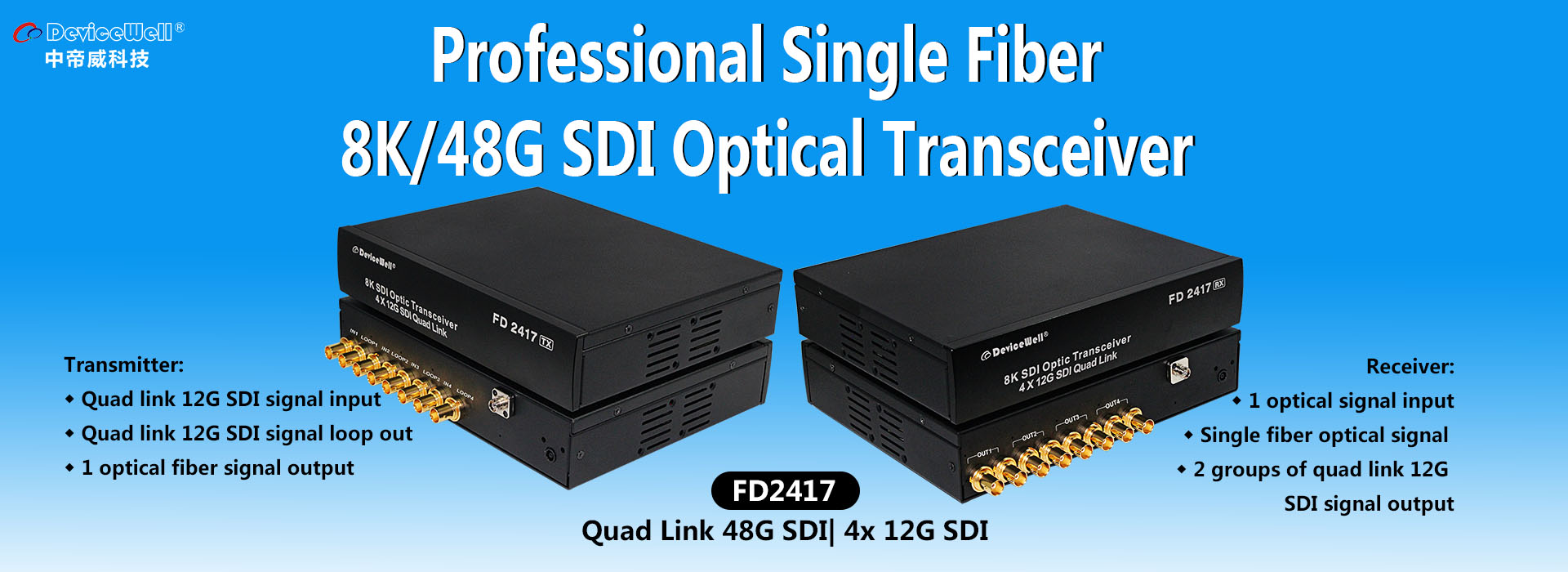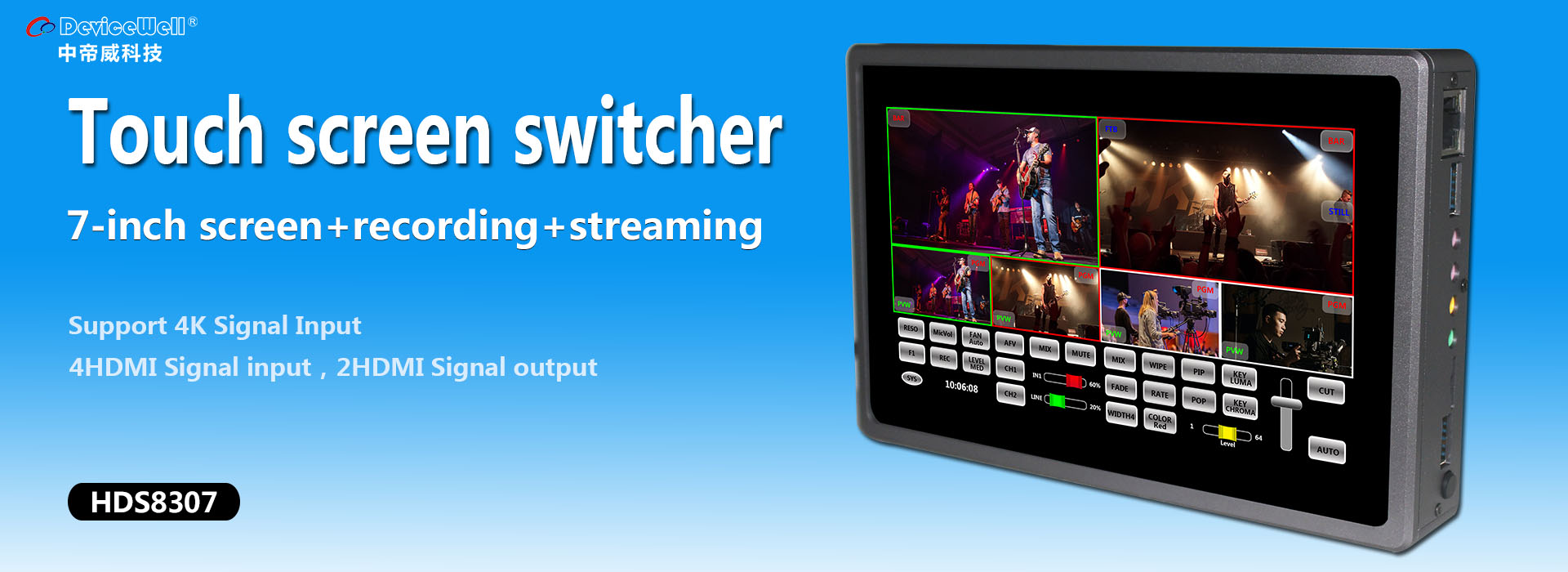How much is the switcher delay?
Science is here! How much is the switcher delay? Let's see how Zhongdiwei explained?
What is the video latency of the device?
Video delay is the time between video input and video output.
Why is there a video delay?
Any video processor needs time to process the video, so there is always a delay.
What is video 0 delay?
Video 0 delay is not without a bit of delay, but the delay is quite small, so small that human vision cannot distinguish it. Because it takes time for human eyes to respond to an image, the speed is too fast, and human eyes cannot react. The earliest movies played 24 frames per second, and then occluded them, and the eyes felt the images were very smooth.
There will always be a delay during video processing. How much delay? The following description uses a guide switcher as an example.
Guide switchers are usually divided into professional and non-professional grades, and the delays of different types of switchers are different.
Professional-grade switchers can basically achieve zero delay, but the signal requirements are too high:
1. Must be synchronized signal input to the switcher, that is, all signals must be synchronized
2. All input signal resolution and frame rate must be the same
The above two conditions must be met at the same time, otherwise it is impossible to achieve zero delay. Because all signals are synchronized and the frame rate is the same, you only need to cut out the signal at a specific line when switching the output. Does it feel simple? In fact, it is not easy to unify the resolution of the signals, but it is not easy to synchronize all the signals. Professional equipment can be completed by adding a synchronization line, but non-professional equipment is troublesome and can only be achieved by adding a frame synchronization machine. . On the one hand, the price of frame synchronizers is high; on the other hand, the frame synchronizer itself has a delay, and the actual effect is also discounted.
There is basically a delay for non-professional switchers, but how much? Delays vary from vendor to vendor.
1. Double-edged sword index: low latency vs high compatibility
Why is it a double-edged sword? Because the delay and compatibility are contradictory, the signal compatibility is good, the delay is usually high, the delay is low, and the signal compatibility may become poor. Ordinary people may not understand, but can only give examples:
You have an old camera that is SD, you have purchased a new high-definition camera, and you want to use a computer to superimpose subtitles, and a wireless signal is transmitted back, a total of 4 signals, you need to enter the switcher.
First of all, let me tell you that a professional-grade switcher must not be used directly.
Some non-professional ones are not used because they mix 4 signals
Usable switchers usually have a large delay. The reason will be described later.
If you change the above equipment, change it to: 4 identical high-definition cameras or 4 identical wireless devices, adjust the device parameters appropriately, and the delay is relatively small. In other words, if you want to be compatible with more devices and more signal types, the delay is relatively large. If you want to have less delay, you can only be compatible with a small number of devices.
2.Cause analysis of delay
Video up / down conversion, frame rate conversion, interlaced / progressive conversion, and video synchronization processing all need to be cached. Cache is to temporarily store the video, and then retrieve it as needed. Once saved, it takes time. This time is the delay time.
3. How to calculate video delay
Accurately calculating the delay of a video is very complicated. As mentioned above, the delay time is related to your compatible signal. Regardless of whether you understand it, some of the following concepts and calculation methods must be written.
Concept one, "field" and "frame"
The video "field" usually refers to the interlaced signal (I), which is generally described as "odd field" and "even field", and the interlaced signal 2 fields = 1 frame
For progressive signals (P), only frames, no field concept
Concept two, "field frequency" and "frame rate" and the time required
"Field frequency" refers to the number of field signals per second. The time of a field is the reciprocal of the field frequency.
"Frame rate" refers to the number of frame signals per second, and the time of one frame is the inverse of the frame rate
Do you understand the above concepts? Don't understand examples of common signals
PAL / 576I50, this refers to the signal is interlaced, 50 fields per second, equivalent to 25 frames, each field time is 20ms
1080I60, this refers to the signal is interlaced, 60 fields per second, equivalent to 30 frames, each field time is 16.7ms
1080P50, this refers to the signal is progressive, 50 frames per second, each frame time is 20ms
Concept 3: De-interlace
That is, the interlaced signal is changed into a progressive signal, and the interlaced signal is a product of the era of the picture tube, because the picture tube must be interlaced. The principle of LCD only supports progressive scanning, so the interlaced signal needs to be changed into progressive signals. In 1080 resolution, the interlaced signal is retained for compatibility with older equipment. In future 4K products, the interlaced (I) signal will no longer be found.
Concept 4: Scaling Up / Scaling Down
Changing low resolution to high resolution is called up-conversion. Changing high resolution to low resolution is called down conversion.
Such as: 576I50 to 1080I50 output is up-converted, otherwise it is down-converted
Concept five, video synchronization
Is to change two videos with different frame rates into videos with the same frame rate
For example, if the frame rate of a video is 50HZ and the output is 60HZ, the 50HZ signal must be synchronized to 60HZ.
With the above concepts, let's calculate some common times
A. Interlaced to progressive
576I50 to 1080P50, about 40ms
B. Video synchronization
1080P30 to 1080P60, about 33ms
4. Accurate video delay calculation
Generally speaking, if the signal compatibility is better, complex video formats must be supported, and the above-mentioned functions such as interlaced to progressive, up / down conversion, video synchronization, etc. must be provided. Concept to deal with. The usual processing method is:
Buffer 1 frame, process 1 frame, output 1 frame
Therefore, the maximum delay time is about 3 frames
For the output frame, because the output position is uncertain, the actual delay is more than 2 frames, about 2.5 frames
Or to illustrate:
1. Input 1080P25HZ output 1080P50HZ, this is an up-conversion application
Buffer 1 frame time: 40ms, processing 1 frame time: 40ms, output 1 frame time: 20ms, total delay is about 0.1 seconds
2. Input 1080I50HZ output 1080P50HZ, this is an interlaced to progressive application
Buffer 1 frame time: 40ms, processing 1 frame time: 40ms, output 1 frame time: 20ms, total delay is about 0.1 seconds
3. Input 1080P60HZ output 1080P50HZ, this is an application of down conversion output
Buffer 1 frame time: 16ms, processing 1 frame time: 16ms, output 1 frame time: 20ms, total delay is about 0.05 seconds
From the above, it can be seen that the up-conversion and interlaced conversion have the largest line-by-line delay. In 0.1 second time, most people's eyes can tell. However, if the input and output settings are good, the delay can be greatly reduced.
Having said so much, the conclusion turned out to be so simple, why not just tell me the result?
In fact, I just want to tell you the result, but you may not believe it after listening, so describe the principle, maybe it will help you a little.
Of course, if you want less delay, you can sacrifice some compatibility, we can remove some processing links, and the delay will be smaller. But we still want better compatibility, sacrificing a little time. If you have different ideas, and you also want to leave a message, we will discuss your opinions internally.
Thank you for your attention!







